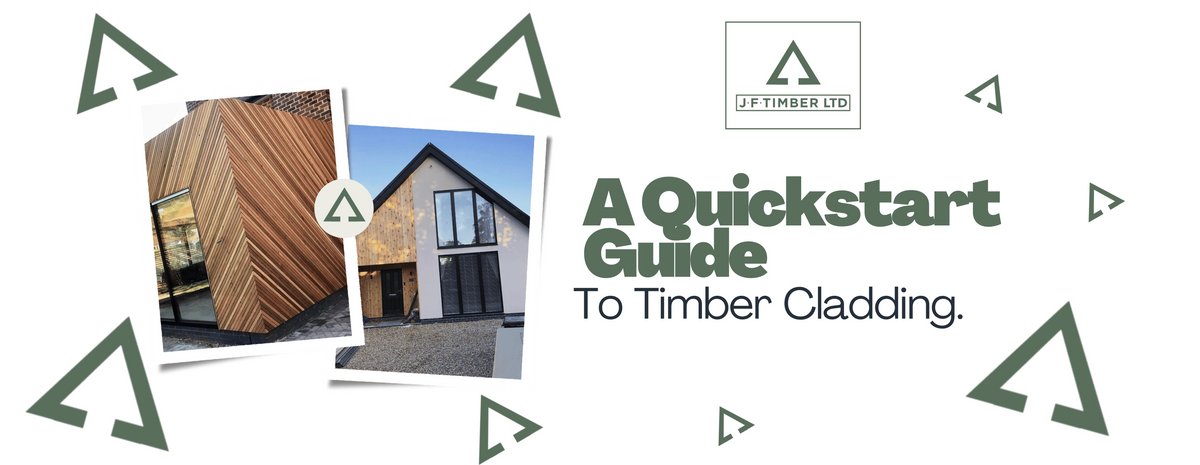
A Quickstart Guide to Choosing Timber Cladding for Your Home
|
|
Time to read 3 min
|
|
Time to read 3 min
Timber cladding offers a timeless appeal, adding warmth, character, and natural beauty to any home. Whether you're renovating an existing property or building a new one, selecting the right timber cladding is a crucial decision that can significantly impact your home's aesthetics, durability, and overall value. In this comprehensive guide, we'll walk you through everything you need to know to make an informed choice when it comes to timber cladding for your home.
Understanding Timber Cladding
Timber cladding, also known as timber siding or timber panelling, involves the application of wooden boards or planks to the exterior walls of a building. It serves both functional and aesthetic purposes, providing protection against the elements while enhancing the visual appeal of the property. Timber cladding comes in a variety of species, profiles, finishes, and installation methods, allowing homeowners to achieve a wide range of architectural styles and design preferences.
The choice of timber species is perhaps the most critical decision when selecting cladding. Each species offers unique characteristics in terms of colour, grain pattern, durability, and sustainability. Popular options include cedar, pine, spruce, larch, oak, and more. Consider factors such as climate suitability, maintenance requirements, and aesthetic preferences when choosing the timber species for your home.
Profile and Texture
Timber cladding is available in various profiles, including horizontal and vertical boards, shiplap, tongue and groove, board-on-board, and more. Each profile creates a distinct visual effect and texture on the facade. Consider the architectural style of your home, as well as the desired aesthetic impact, when selecting the cladding profile.
Grading
Timber cladding grading specifications are essential guidelines that classify timber based on its quality, appearance, and suitability for various applications. These specifications ensure consistency and transparency in the timber industry, allowing customers to make informed decisions. Grading typically involves assessing timber boards for defects such as knots, splits, and grain irregularities, with higher grades indicating fewer and smaller defects. Grading depends on the species.
Additionally, grading specifications consider the timber's moisture content, structural integrity, and durability, ensuring that the selected timber meets the performance and aesthetic requirements of the intended project.
For more information on grading, stay tuned for our individual species blogs.
Finish and Treatment
The finish and treatment of timber cladding play a significant role in its durability, longevity, and appearance. Options range from natural finishes that allow the timber to age and weather gracefully to stained, painted, or fire-treated finishes that provide additional protection and customisation. Consider the level of maintenance required for each finish option and choose one that aligns with your lifestyle and preferences. To prevent the natural silvering of timber cladding, we recommend Osmo Oil.
Environmental Impact
Sustainability is an essential consideration in modern construction practices. Look for timber cladding that is sourced from responsibly managed forests or certified by reputable forestry organisations such as the Forest Stewardship Council (FSC) or the Programme for the Endorsement of Forest Certification (PEFC). Opting for sustainable timber helps reduce environmental impact and supports responsible forestry practices.
Budget and Cost
When considering timber cladding costs, it's essential to take into account several factors that can influence the overall price. These factors include the specific species of timber used, the grade of the wood, the profile and finish of the cladding, as well as the method of installation. By carefully considering these variables, you can set a realistic budget for your cladding project. It's important to explore various options and strike a balance between quality, aesthetics, and affordability that aligns with your financial constraints.
Installation and Maintenance
After carefully selecting the most suitable timber cladding for your home, it is crucial to focus on proper installation and maintenance to maximise its longevity and performance. When it comes to installation, it is advisable to either engage experienced professionals or meticulously follow the manufacturer's guidelines for correct installation practices. This is essential to prevent potential issues such as moisture infiltration, warping, and decay, which can significantly impact the durability and appearance of the cladding over time.
In addition to the initial installation, it is important to establish a comprehensive maintenance routine for your timber cladding. This routine should include regular cleaning to remove dirt, debris, and other environmental contaminants that can accumulate on the surface. Furthermore, periodic inspections are vital to identify any signs of damage or wear, allowing for timely repairs to be carried out. These repairs may include addressing any loose or damaged cladding boards, as well as addressing any issues related to the sealant or finish that protects the wood.
By staying proactive with maintenance, you can ensure that your timber cladding retains its aesthetic appeal and structural integrity for many years to come. This not only enhances the overall appearance of your home, but also safeguards the investment you've made in your property.
Conclusion
Choosing timber cladding for your home is an exciting opportunity to enhance its beauty, durability, and value. By considering factors such as timber species, profile, finish, sustainability, and budget, you can select cladding that perfectly complements your home's style and meets your practical needs. With proper installation and maintenance, timber cladding can transform your home's exterior into a timeless masterpiece that you'll enjoy for years to come.
Timber Species at J F Timber
